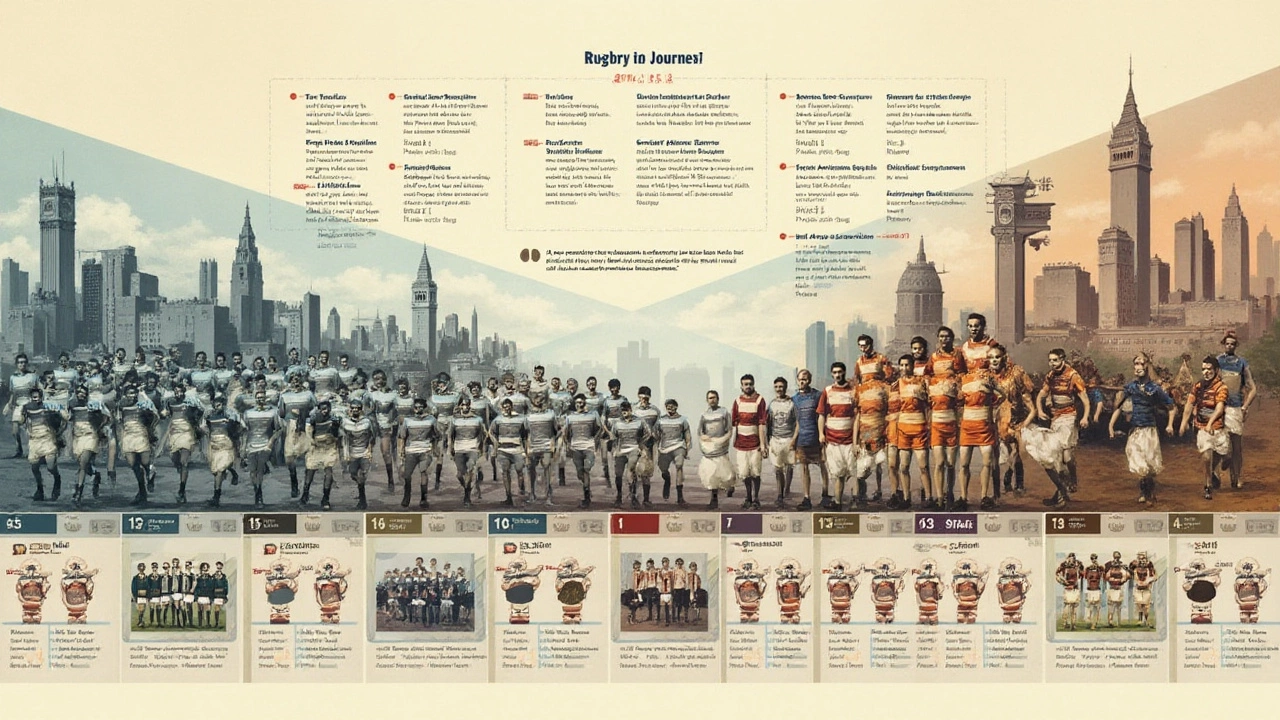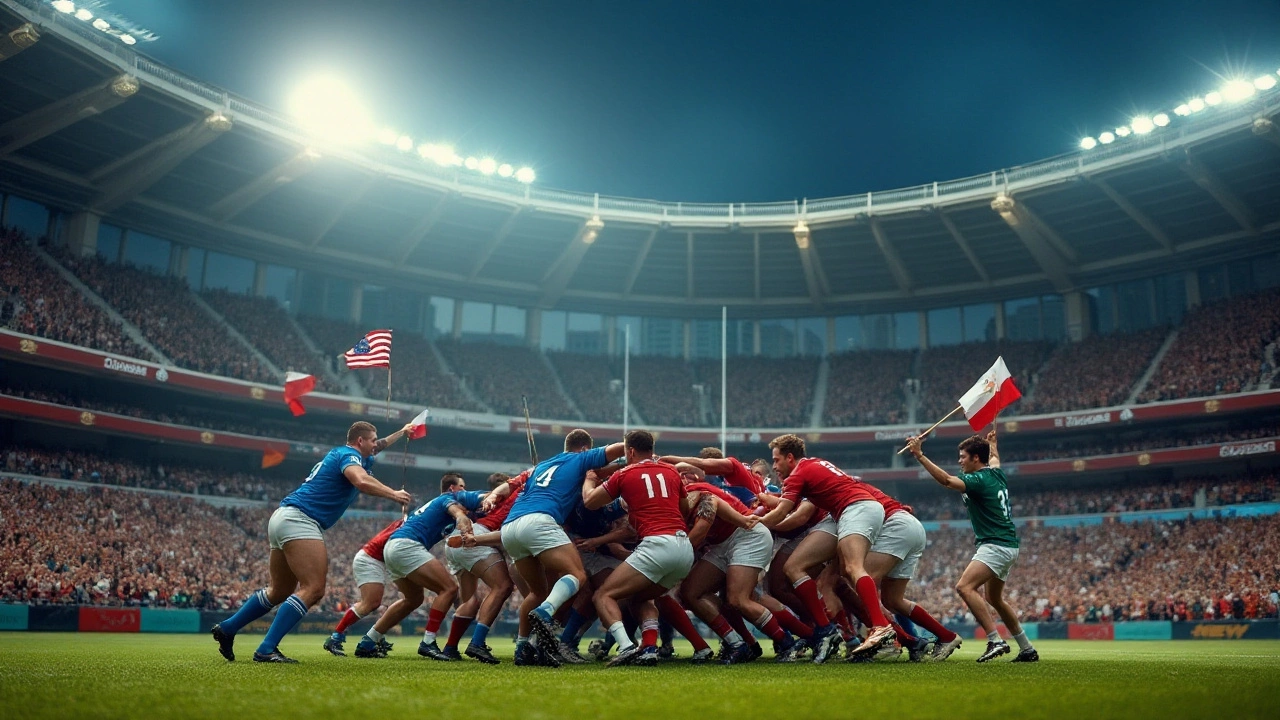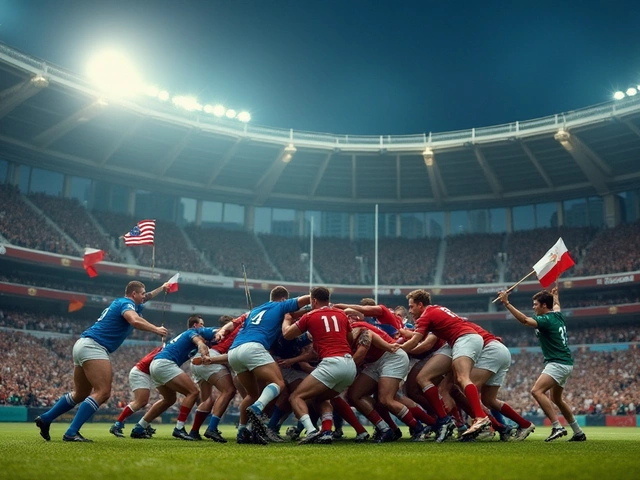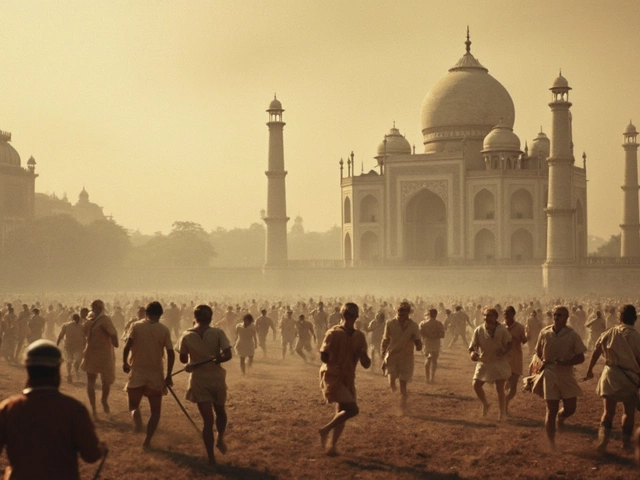Rugby is a sport of grit and grace, loved by millions worldwide. However, its journey in capturing the hearts of Americans has been less triumphant. While it boasts a rich history and global fanbase, rugby sits in the shadows of mainstream American sports.
To understand why rugby hasn't found a larger audience in the U.S., we need to explore a variety of factors. We'll look at the history, see how it stacks up against the homegrown obsession with football, and consider cultural nuances. Join us as we uncover not just the causes of rugby's challenges here, but also the potential pathways to a brighter future.
- Historical Context of Rugby
- Comparison with American Football
- Demographic and Cultural Barriers
- Rugby Structure and Organization in the US
- Media and Sponsorship Challenges
- Opportunities for Growth
Historical Context of Rugby
The origins of rugby trace back to the early 19th century in England, where it emerged from the traditional game of football. Legend has it that during a school match in 1823, William Webb Ellis picked up the ball and ran with it. This act is often celebrated as the act that birthed the game of rugby as we know it. Over the decades, rugby evolved, capturing a significant following around the world, especially in countries like New Zealand, South Africa, and Australia, where it would become a national pastime. The rugby union was founded in 1871, laying down formal rules that somewhat resemble those of today.
In the United States, rugby's introduction coincided with the development of American football, a sport that initially drew heavily from rugby. Early versions of American football were rugby-like, with players oftentimes forming scrums and using a similar-shaped ball. As collegiate rugby clubs began to form, notably in Ivy League institutions, there was a time during the late 19th century when rugby and American football coexisted on campuses across the nation. However, due to the efforts of key figures like Walter Camp, known as the 'Father of American Football,' the trajectory of rugby and football in the U.S. bifurcated drastically.
Going into the 20th century, American football developed its unique identity. It incorporated elements such as the forward pass and a marked shift in safety regulations, carving out a unique niche distinctly separate from rugby. During the intervening years, rugby found itself rooted in smaller pockets of enthusiast communities primarily concentrated in coastal regions. Unlike football, it did not achieve institutional support nor the commercial backing necessary for nationwide endorsement.
"Rugby had the chance to become the leading contact sport in America, but the strategies and appeal of American football resonated with American ideals of exhilarating offense and strategic play," remarked sports historian Dr. Evelyn Silverman in her discussion of American sports evolution.
Despite America's early involvement in the sport—culminating in the U.S. team's gold medal wins at the Olympic Games in 1920 and 1924—rugby dwindled significantly as American football cemented its place in the cultural fabric of the nation. Post-World War II, rugby made sporadic resurgences in popularity, often parallel to waves of cultural shifts and immigration patterns. Yet, it never managed to shed its image as a niche, expatriate community activity.
Today, modern rugby in America is slowly building momentum, mindful of its rich historical roots and potential to engage a new generation. Yet it continues to face the same historical challenges that have impeded its growth. Understanding this context is vital to comprehending not just where rugby comes from but where it might go as it attempts to stake a claim within U.S. sports culture.
Comparison with American Football
When most people in the United States think of football, they're picturing the gridiron spectacle of the NFL, defined by helmets, pads, and tactical plays. American football has become more than a sport; it's a cultural event, woven deeply into the fabric of American society. Meanwhile, rugby, without its armor and with its continuous play, presents a strikingly different vision of what a sport can be. Both sports share a lineage with rugby having its roots in the same ancestor but have diverged immensely in terms of style, strategy, and identity. American football focuses on territorial advances punctuated by huddles and elaborate playbooks, while rugby celebrates fluidity and the age-old contest of physical endurance across its 80 minutes of motion.
The contrasts extend beyond the field, touching on cultural attitudes and institutional support. American football enjoys the lion's share of attention, both from media giants and educational institutions. Universities across the U.S. pour resources into their programs, making college football almost as sacrosanct as the professional leagues. This scaffolding is missing for rugby, which remains a club sport at many schools. Despite rugby's reputation as one of the world's leading sports, in the U.S., it's often overshadowed by local centric sports culture. The NFL's Super Bowl, a showcase of American football, exemplifies this divide by being one of the most-watched sporting events on the planet, drawing in audiences for not just the game, but the commercials and half-time show that contribute to its pageantry.
In terms of visibility and reach, rugby struggles to match the force of American football. Major networks dedicate hours to football programming, while rugby fights for airtime, often nestled in niche sports channels or cable packages. In a revealing statement, a
respected sports analyst once noted, "American football is less about fulfilling its duty as a sport and more about performing as a spectacle."It's this spectacle that garners attention, from tailgates to extensive pre-game shows, leaving rugby in a quieter realm of athleticism and camaraderie. Another factor contributing to American football's dominance is its entrenched fanbase, which has been nurtured over decades through both grassroots efforts and a system that feeds the profession from high school to the NFL.
The challenge rugby faces lies not just in its structural and promotional differences but in how deeply American football impacts the sports psyche. The language of yards and touchdowns forms part of daily dialogue, bonding communities and generations. To build a robust presence, rugby would need a strategic shift, focusing on its unique attributes that cater to the thematic and athletic diversity within sports enthusiasts. Education about the rules and its thrilling pace could help demystify the game for newcomers. Stronger grassroots initiatives and investment in youth programs are necessary to create pathways similar to those established for football players. It is this multi-faceted approach that will, over time, potentially elevate the American rugby profile closer to its football cousin.

Demographic and Cultural Barriers
Understanding why rugby hasn't gained widespread popularity in the United States inevitably leads us to a complex web of demographic and cultural factors. First, consider America's deeply entrenched sporting landscape. Dominated by institutions like the NFL, NBA, and MLB, there is simply limited space for another major sport. These leagues have not just captured the market; they have become woven into the fabric of American culture, leaving minimal room for newcomers like rugby.
Another cultural hurdle lies in the perception of rugby as a foreign sport. Unlike American football, which shares some similarities, rugby originated and evolved outside the United States. This can make it feel less accessible and relatable to a public that is deeply immersed in homegrown sports traditions. Coupled with varying rule structures and gameplay styles compared to more familiar sports, rugby often seems like an enigma that requires extra effort to understand and appreciate.
"Rugby is not just a sport; it's an institution in countries like New Zealand, South Africa, and the UK. But in the U.S., its story is still being written," says Matthew McCarthy, host of the Rugby Wrap Up podcast.
Geography and accessibility also play crucial roles in shaping sporting preferences. With its expansive territory, the U.S. has varied regional sports cultures. The South favors American football, the Northeast leans toward basketball, and every region has its preferences. Rugby must contend with these established loyalties that differ by region and sometimes even by city. Additionally, the infrastructure for supporting rugby—from established youth programs to local clubs—is still underdeveloped compared to the support systems offered to sports like American football and basketball.
A demographic survey reveals shifting tides with changing generations. Younger Americans are showing heightened interest in sports outside the traditional quartet of football, basketball, baseball, and hockey. This is where American rugby has seen budding growth, especially within universities and cities with expatriate communities who bring their passion for the sport from overseas.
Furthermore, rugby's standing is often hampered by misconceptions related to safety and intensity. With discussions surrounding player welfare in contact sports, parents might hesitate to introduce their children to rugby, fearing injury despite evidence suggesting rugby can be safer than American football in many respects.
Statistics and Growing Pains
Statistics highlight promising trends despite these barriers. According to USA Rugby reports, participation among youth has been steadily increasing by around 5% annually over the past decade. Moreover, the advent of Major League Rugby (MLR), though still in its infancy, has brought professional visibility to the sport, attracting a diverse mix of seasoned players and newbies intrigued by rugby's distinct blend of athleticism and team spirit.
Looking ahead, rugby's challenge—and opportunity—is to carve a niche within a saturated market. Success might hinge on targeting untapped demographics, ramping up grassroots programs, and fostering a broader understanding of the sport's unique appeal among Americans. The path isn't without its hurdles, but the evolving demographics and shifting cultural landscapes offer glimmers of hope for rugby enthusiasts and administrators alike.
Rugby Structure and Organization in the US
In the United States, rugby is a tapestry of passionate playgrounds and organizational intricacies. It’s a game played on weekends by devoted enthusiasts and complexity managed by governing bodies striving to streamline the sport's development. The heart of the game often lies in grassroots clubs scattered across the country, where players of all ages and skill levels gather with a shared love for the game. Yet, when it comes to formal organization, rugby in the U.S. tends to be fragmented compared to an organized juggernaut like American rugby, with its structured leagues and powerful broadcasts. The landscape is populated by a multitude of clubs, leagues, and governing bodies that operate at national, regional, and collegiate levels. This distributed nature can sometimes lead to operational challenges, both in terms of logistics and in fostering a seamless growth trajectory for the sport.
At the apex of this hierarchy is USA Rugby, the national governing body charged with steering the sport. USA Rugby's mandate is broad, encompassing everything from player safety and youth programs to elite national teams that represent the US sports scene internationally. Despite their efforts, issues such as inconsistent funding and fluctuating support have occasionally slowed progress. However, initiatives like the establishment of Major League Rugby (MLR) in 2018 have injected new life into the professional side of the game. With about a dozen teams covering cities coast-to-coast, MLR aims to mirror the success of rugby leagues overseas, providing a professional platform for players and an exciting spectacle for fans. Opinions within the rugby community are mixed, with some praising its growth potential and others questioning its sustainability in an already crowded sports market.
Tom Billups, a respected coach and former national team player, once said, "Rugby in the U.S. has always been about the community, but what we need now is a sense of unified ambition." This sentiment is echoed in various training grounds and strategy sessions where coaches and players dream of a day when rugby can command the same respect and affection as football or basketball in America.Local clubs play a critical role, often becoming nuclei of local engagement and outreach. They serve as breeding grounds for aspiring athletes and are pivotal in introducing the game to new audiences. Yet, these efforts often happen in silos, without the broader coordination seen in other dominant American sports. While there is enthusiasm in pockets, the challenge remains to weave these independent patches into a cohesive national quilt that can sustain growth and attract investment.
Looking ahead, the rise of rugby in high schools and universities offers a promising channel for nurturing young talent. Many institutions are starting to adapt their athletic programs to include rugby, recognizing its growing popularity as both a women's and men's sport. The National Collegiate Rugby Organization seeks to create competitive opportunities for emerging players, and some colleges now offer scholarships to athletes, marking a step towards professionalizing the sport. As participation numbers inch upwards, the focus will likely shift towards better training facilities, effective coaching, and more robust competition structures that mirror the successful models of rugby's global powerhouses.
The path for rugby popularity in the U.S. isn’t without its hurdles, but it is underscored by determination and passion. With continued strategic focus, deeper community involvement, and improved media exposure, rugby has the potential to carve out a meaningful niche in the diverse sports culture of the United States.

Media and Sponsorship Challenges
In America, the visibility of sports heavily relies on media coverage and sponsorship deals, which play a crucial role in driving fan engagement. Rugby has long been tethered by limited exposure on major networks. Unlike its American counterpart, football, which enjoys primetime slots on several channels, rugby often finds itself relegated to niche sports networks, making it difficult for casual fans to stumble across a match and potentially become supporters. The lack of consistent broadcasting limits its storytelling capabilities. Stories of triumph, legendary matches, and player biographies are key factors that help in developing a connection between a sport and its fans, yet these stories are scarcely told in the U.S. due to limited airtime.
The financial clout of media corporations heavily influences how sports are promoted. American football, for instance, thrives on billion-dollar deals with broadcasters, a luxury that rugby is far from enjoying. Without substantial financial backing from media rights, rugby struggles to offer the kind of commercial allure that makes sports profitable. The function and role of sponsorships cannot be ignored either. Sponsorship deals are closely linked to television exposure since companies invest more where they reap brand visibility benefits.
"The audience speaks. Sponsors listen," said a spokesperson from a leading sports marketing firm during a recent panel on sports sponsorship dynamics. Without significant media coverage, potential sponsors find it hard to justify substantial investments into American rugby. This vicious cycle hampers the potential growth of the sport.
The challenges extend beyond mere airplay. Rugby's fragmented structure in the U.S. does little to attract national sponsors. While there have been efforts like the establishment of Major League Rugby, the sport lacks a unified narrative to sell. Comparatively, other sports have invested heavily in building narratives around perpetual rivalries, marquee events, and star athletes. Rugby, on the other hand, has struggled to spotlight its athletes. Initiatives to rename key positions or govern more aesthetically pleasing uniforms have seen success in other sports, yet rugby seems to be holding on to tradition without considering market preferences, which sometimes conflicts with potential sponsorship interests.
Despite these hurdles, there are glimmers of hope. The accelerating rise of streaming platforms has opened new doors for rugby in America. Services like Peacock have begun sharing matches, which democratizes access compared to traditional cable. This transition presents an opportunity, particularly among younger demographic groups that favor streaming services. With rugby's core values of teamwork and discipline resonating well within many communities, there is optimism that with strategic media partnerships, the sport can gain ground. American rugby must also look towards integrating innovative technologies like AR or VR into their broadcasts, something that has proven successful in engaging audiences in other sports.
The path forward involves building a more cohesive marketing strategy that promotes rugby's unique aspects. Collaborating with digital media influencers to engage with American audiences on platforms like Instagram and TikTok could see some success. Utilizing these channels to showcase the exhilarating moments of the sport or its educational aspect through short, engaging content can be quite effective. The vast landscape of social media signifies an untapped well of potential that could be harnessed to revitalize the sport's image and reach, subsequently attracting both media attention and sponsorships interested in fresher demographics.
Opportunities for Growth
If we consider the future of rugby in the United States, we recognize a myriad of avenues that could pave the way for rugby to shine within the vast landscape of American sports. One pivotal approach revolves around grassroots development. Establishing more youth programs and enhancing access to rugby clubs could nurture a new generation of players who hold the sport close to their hearts from a young age. Initiating school-based programs and aligning with local communities can cultivate not just players but also lifelong fans.
Another significant stride involves leveraging the power of media. Compared to cricket or baseball, which have well-established broadcast channels, rugby’s presence on television and digital platforms is relatively nascent. Collaborations with major networks to showcase high-profile matches, along with tailored content for streaming services, can increase exposure. Social media campaigns that celebrate thrilling moments in rugby, much like those ubiquitous slam dunk clips in the NBA, can help in capturing the imagination of a younger audience.
Tournaments and local leagues could be more widely advertised to increase engagement. Recent trends show an uptick in attendance and viewership among college and club-level rugby events, indicating an appetite for the sport when presented right. Investment in better facilities and the modernization of existing ones could create attractive venues for hosting matches that lure in crowds.
Opportunities also lie in tapping into American rugby's niche markets. Unexpected alliances with popular sporting events, like halftime rugby showcases or rugby-inspired competitions during football seasons, could intrigue casual fans. Creating connections between rugby and popular sports through fun and engaging events could spark curiosity and enthusiasm. Initiatives like these have paid dividends in other sports. For instance, soccer's growth in America owes much to its strategic push in schools, colleges, and aligning with mainstream events.
Moreover, tapping into rugby's diverse international appeal can play a role in its story. Emphasizing the game as a multicultural and globally connected sport might attract a diverse fan base, including expatriate communities yearning for a taste of their homeland's sports culture. Collaborations with international rugby festivals or friendly matches with renowned rugby teams can showcase the game’s rich cultural tapestry to the American audience. In fact, an encouraging note from a past ESPN article claimed that "rugby’s potential to unify and celebrate diverse cultures is unmatched."
Resonating with the internationally-minded segment of the U.S. population presents an opportunity to let rugby grow roots. Small yet concrete steps can pay off. Hosting major events, like the Rugby World Cup, not only widens exposure but also stimulates local economies, weaving the sport into the fabric of community life across the nation.





